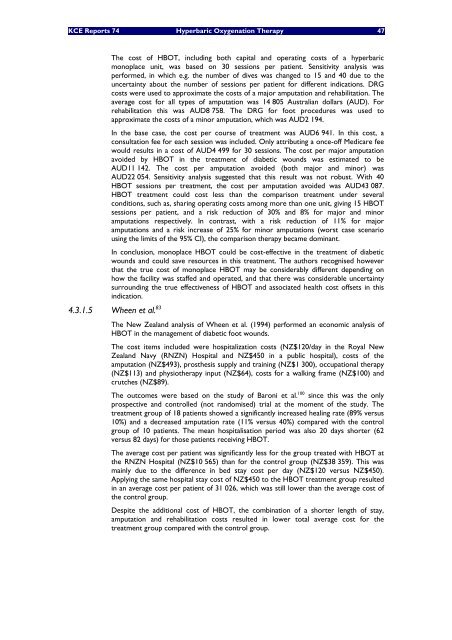Hyperbare Zuurstoftherapie: Rapid Assessment - KCE
Hyperbare Zuurstoftherapie: Rapid Assessment - KCE
Hyperbare Zuurstoftherapie: Rapid Assessment - KCE
Create successful ePaper yourself
Turn your PDF publications into a flip-book with our unique Google optimized e-Paper software.
<strong>KCE</strong> Reports 74 Hyperbaric Oxygenation Therapy 47<br />
The cost of HBOT, including both capital and operating costs of a hyperbaric<br />
monoplace unit, was based on 30 sessions per patient. Sensitivity analysis was<br />
performed, in which e.g. the number of dives was changed to 15 and 40 due to the<br />
uncertainty about the number of sessions per patient for different indications. DRG<br />
costs were used to approximate the costs of a major amputation and rehabilitation. The<br />
average cost for all types of amputation was 14 805 Australian dollars (AUD). For<br />
rehabilitation this was AUD8 758. The DRG for foot procedures was used to<br />
approximate the costs of a minor amputation, which was AUD2 194.<br />
In the base case, the cost per course of treatment was AUD6 941. In this cost, a<br />
consultation fee for each session was included. Only attributing a once-off Medicare fee<br />
would results in a cost of AUD4 499 for 30 sessions. The cost per major amputation<br />
avoided by HBOT in the treatment of diabetic wounds was estimated to be<br />
AUD11 142. The cost per amputation avoided (both major and minor) was<br />
AUD22 054. Sensitivity analysis suggested that this result was not robust. With 40<br />
HBOT sessions per treatment, the cost per amputation avoided was AUD43 087.<br />
HBOT treatment could cost less than the comparison treatment under several<br />
conditions, such as, sharing operating costs among more than one unit, giving 15 HBOT<br />
sessions per patient, and a risk reduction of 30% and 8% for major and minor<br />
amputations respectively. In contrast, with a risk reduction of 11% for major<br />
amputations and a risk increase of 25% for minor amputations (worst case scenario<br />
using the limits of the 95% CI), the comparison therapy became dominant.<br />
In conclusion, monoplace HBOT could be cost-effective in the treatment of diabetic<br />
wounds and could save resources in this treatment. The authors recognised however<br />
that the true cost of monoplace HBOT may be considerably different depending on<br />
how the facility was staffed and operated, and that there was considerable uncertainty<br />
surrounding the true effectiveness of HBOT and associated health cost offsets in this<br />
indication.<br />
4.3.1.5 Wheen et al. 83<br />
The New Zealand analysis of Wheen et al. (1994) performed an economic analysis of<br />
HBOT in the management of diabetic foot wounds.<br />
The cost items included were hospitalization costs (NZ$120/day in the Royal New<br />
Zealand Navy (RNZN) Hospital and NZ$450 in a public hospital), costs of the<br />
amputation (NZ$493), prosthesis supply and training (NZ$1 300), occupational therapy<br />
(NZ$113) and physiotherapy input (NZ$64), costs for a walking frame (NZ$100) and<br />
crutches (NZ$89).<br />
The outcomes were based on the study of Baroni et al. 100 since this was the only<br />
prospective and controlled (not randomised) trial at the moment of the study. The<br />
treatment group of 18 patients showed a significantly increased healing rate (89% versus<br />
10%) and a decreased amputation rate (11% versus 40%) compared with the control<br />
group of 10 patients. The mean hospitalisation period was also 20 days shorter (62<br />
versus 82 days) for those patients receiving HBOT.<br />
The average cost per patient was significantly less for the group treated with HBOT at<br />
the RNZN Hospital (NZ$10 565) than for the control group (NZ$38 359). This was<br />
mainly due to the difference in bed stay cost per day (NZ$120 versus NZ$450).<br />
Applying the same hospital stay cost of NZ$450 to the HBOT treatment group resulted<br />
in an average cost per patient of 31 026, which was still lower than the average cost of<br />
the control group.<br />
Despite the additional cost of HBOT, the combination of a shorter length of stay,<br />
amputation and rehabilitation costs resulted in lower total average cost for the<br />
treatment group compared with the control group.

















